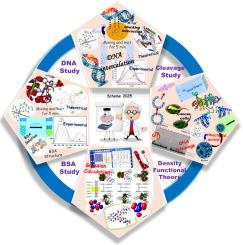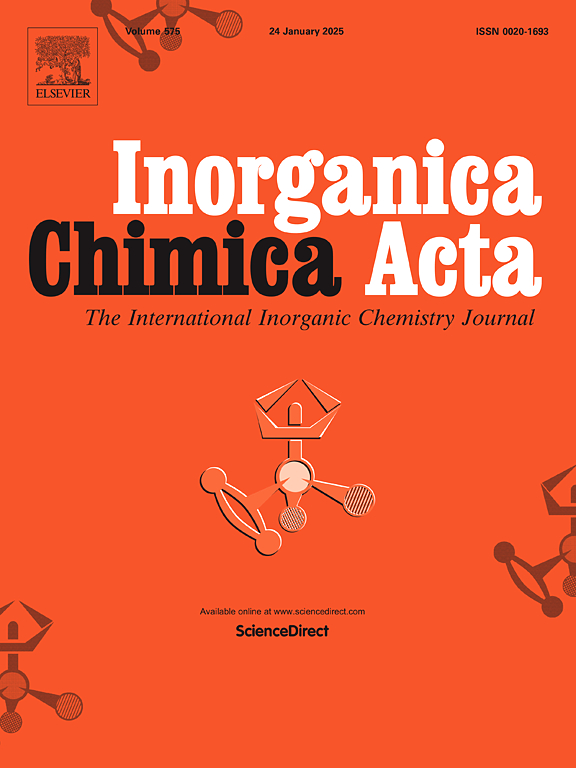N,O螯合剂钴(III)/铜(II)配合物的合成及其DFT优化和生物学评价
IF 3.2
3区 化学
Q2 CHEMISTRY, INORGANIC & NUCLEAR
引用次数: 0
摘要
合成了三种不同的金属配合物[Co(nal)2phen], 1a, [Co(bipyam)2] 1b和[Cu(bpy)(1- melm)(H2O)Cl], 1c(其中nal =萘啶酸,bpy = 2,2 ' -联吡啶,phen = 1,10-菲洛啉,bipyam = 2,2 ' -联吡啶胺和1- melm = 1-甲基咪唑),并通过紫外/可见,FT-IR,质谱和x射线晶体学测量对其进行了结构表征。配合物1b的四坐标采用正方形平面,六坐标配合物和五坐标配合物(1a & 1c)呈现畸变的八面体和四面体几何构型。利用密度泛函理论(DFT)计算优化了配合物的分子轨道描述。利用一系列的生物物理技术来检测复合物(1a-1c)与牛血清白蛋白和DNA的体外结合研究。观察结果表明,在BSA的IIIA亚结构域和DNA螺旋的磷酸主链中,配合物(1a-1c)具有较强的结合相互作用,并符合1a >; 1c >; 1c的趋势。此外,通过电泳迁移率谱法研究了配合物对BSA和DNA的裂解能力的变化,得出配合物具有优异的裂解能力的结论。配合物(1a-1c)的计算(MD)研究归因于与金属中心结合的配体的性质,影响其体外活性。抗菌研究表明,与新霉素和其他配合物相比,1a抑制区最大。此外,这些复合物还显示出对DPPH自由基的显著抗氧化活性。对三种癌细胞系(MCF-7, A-549和HeLa)的细胞毒性研究表明,与nal和phen配体的复合物1a分别在24 h和48 h表现出更高的毒性。本文章由计算机程序翻译,如有差异,请以英文原文为准。

Synthesis of cobalt(III)/copper(II) complexes of N,O chelators and their DFT optimization and biological evaluation
Three different metal complexes of formula [Co(nal)2phen], 1a, [Co(bipyam)2] 1b and [Cu(bpy)(1-Melm)(H2O)Cl], 1c (where nal = nalidixic acid, bpy = 2,2′-bipyridine, phen = 1,10-phenanhroline, bipyam = 2,2′-dipyridylamine and 1-Melm = 1-methylimidazole) have been synthesized and structurally characterized by UV/visible, FT-IR, mass spectrometry and X-ray crystallography measurements. The tetra-coordinate of complex 1b adopts a square planar and hexa- and penta-coordinate complexes (1a & 1c) show distorted octahedral and tetrahedral geometry configurations. Density functional theory (DFT) calculations were used to optimize the molecular orbital depiction for the complexes. Utilizing a series of biophysical techniques to examine the in vitro binding studies of complexes (1a-1c) with BSA and DNA. The observed results were satisfied with strong binding interaction of complexes (1a-1c) in the subdomain IIIA of BSA as well as in the phosphate backbone of the DNA helix and follow the trend 1a > 1c > 1c. In addition, the variation in the ability of complexes to cleave BSA and DNA has also been explored by electrophoretic mobility spectrometry, which concluded that complexes have excellent cleavage ability. The computational (MD) study of the complexes (1a-1c) was attributed to the nature of ligands bound to the metal centre that influences their in vitro activities. The antibacterial study concluded that the largest inhibition zone occurred in 1a as compared to neomycin and other complexes. Further, these complexes have also revealed a significant antioxidant activity against DPPH radical. Cytotoxicity studies on three cancer cell lines (MCF-7, A-549 & HeLa) showed that complex 1a with the nal and phen ligands exhibited higher toxicity at both 24 h & 48 h, respectively.
求助全文
通过发布文献求助,成功后即可免费获取论文全文。
去求助
来源期刊

Inorganica Chimica Acta
化学-无机化学与核化学
CiteScore
6.00
自引率
3.60%
发文量
440
审稿时长
35 days
期刊介绍:
Inorganica Chimica Acta is an established international forum for all aspects of advanced Inorganic Chemistry. Original papers of high scientific level and interest are published in the form of Articles and Reviews.
Topics covered include:
• chemistry of the main group elements and the d- and f-block metals, including the synthesis, characterization and reactivity of coordination, organometallic, biomimetic, supramolecular coordination compounds, including associated computational studies;
• synthesis, physico-chemical properties, applications of molecule-based nano-scaled clusters and nanomaterials designed using the principles of coordination chemistry, as well as coordination polymers (CPs), metal-organic frameworks (MOFs), metal-organic polyhedra (MPOs);
• reaction mechanisms and physico-chemical investigations computational studies of metalloenzymes and their models;
• applications of inorganic compounds, metallodrugs and molecule-based materials.
Papers composed primarily of structural reports will typically not be considered for publication.
 求助内容:
求助内容: 应助结果提醒方式:
应助结果提醒方式:


